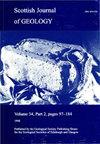Ice-rafting in lakes in the early Neoproterozoic: dropstones in the Diabaig Formation, Torridon Group, NW Scotland
IF 1.3
4区 地球科学
Q4 GEOLOGY
引用次数: 4
Abstract
A dropstone horizon is described from lake deposits in a palaeo-valley from the c. 1000 Ma Diabaig Formation, Torridon Group, NW Scotland. Dropstones occur in wave-rippled, fine-grained sandstones and siltstones that contain desiccation and syneresis cracks indicative of fluctuating lake levels. Five locally derived dropstones occur at the same horizon over lateral distance of 250 m and display clear evidence of deflection and penetration of laminae at the base, with thinning, onlap and draping of laminae on to clast margins and tops. Mechanisms of dropstone formation are discussed, with ice-rafting considered the most likely explanation. It is suggested that rafting was promoted by cold winters at 35° S in the early Neoproterozoic, possibly in an upland setting. Interpretation of the dropstones as ice-rafted debris provides the first physical record of evidence for ice at the Earth's surface during the late Mesoproterozoic to early Neoproterozoic.新元古代早期湖泊中的漂流:苏格兰西北部Torridon群Diabaig组中的落石
在苏格兰西北部Torridon组约1000 Ma Diabaig组古山谷的湖泊沉积物中描述了一个坠石层。水滴石出现在波浪起伏的细粒砂岩和粉砂岩中,其中含有指示湖泊水位波动的干燥和协同作用裂缝。在250米的横向距离上,在同一水平面上出现了5个局部衍生的坠石,并显示出底部层状岩的偏转和穿透的明显证据,层状岩在碎屑边缘和顶部上变薄、覆盖和覆盖。讨论了水滴石形成的机制,其中漂流被认为是最可能的解释。推测在新元古代早期,南纬35°的寒冷冬季促进了漂流,可能是在高原环境下。将坠石解释为冰筏碎片提供了中元古代晚期到新元古代早期地球表面冰的第一个物理记录。
本文章由计算机程序翻译,如有差异,请以英文原文为准。
求助全文
约1分钟内获得全文
求助全文
来源期刊

Scottish Journal of Geology
地学-地质学
CiteScore
1.70
自引率
0.00%
发文量
10
审稿时长
>12 weeks
期刊介绍:
Although published only since 1965, the Scottish Journal of Geology has a long pedigree. It is the joint publication of the Geological Society of Glasgow and the Edinburgh Geological Society, which prior to 1965 published separate Transactions: from 1860 in the case of Glasgow and 1863 for Edinburgh.
Traditionally, the Journal has acted as the focus for papers on all aspects of Scottish geology and its contiguous areas, including the surrounding seas. The publication policy has always been outward looking, with the Editors encouraging review papers and papers on broader aspects of the Earth sciences that cannot be discussed solely in terms of Scottish geology.
The diverse geology of Scotland continues to provide an important natural laboratory for the study of earth sciences; many seminal studies in geology have been carried out on Scottish rocks, and over the years the results of much of this work had been published in the Journal and its predecessors.
The Journal fully deserves its high reputation worldwide and intends to maintain its status in the front rank of publications in the Earth sciences.
 求助内容:
求助内容: 应助结果提醒方式:
应助结果提醒方式:


